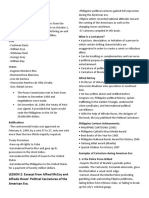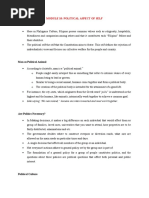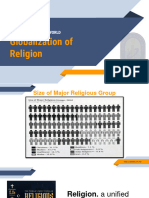Module 2 - Lesson 2
Uploaded by
renz daveModule 2 - Lesson 2
Uploaded by
renz dave9
Lesson 2
The Internet
What is the Internet?
The Internet, sometimes called simply "the Net" (also called Cloud), is a
global network of billions of computers and other electronic devices. With the
Internet, it's possible to access almost any information, communicate with
anyone else in the world, and do much more.
You can do all of this by connecting a computer or device to the Internet,
which is also called going online. When someone says a computer is online, it is
just another way of saying it is connected to the Internet.
Origins of the Internet
The origin of the internet can be traced back to its original use in military
and universities. You may be surprised that the internet is just an evolution of
computer networks that started between military computers with the initial goal
of maintaining the safe transition of data.
Let us take a look at a brief history of the internet. It all started with the
ARPAnet. We will see how computers were kept added to this network all
throughout the years. Understand the history of the internet by reading the time
line below.
1957: The United States Department of Defense put a high priority on research
and projects in science and technology and created an agency called ARPA
(Advanced Research Projects Agency) in response to Soviet Union’s spacecraft
satellite called Sputnik.
1962: The birth of ARPANET (ARPA Network). These are network of computers
in the ARPA that allowed a communication of information between computers.
1969: By the end of 1969, only four computers are connected to the ARPAnet.
1971: By this year, universities were involved in the propagation of computers
that are connected to the ARPANET. There were 23 computers in different
universities and institutes in the United States connected to ARPANET.
This year was also believed to be the year when Email was invented and Ray
Tomlinson was credited as the inventor, though some have different stories of
who the inventor is.
1973: Vinton "Vint" Cerf, an American computer scientist, and Robert E. "Bob"
Kahn, an American engineer and computer scientist, started a project to develop
Transmission-Control Protocol (TCP), which allowed the ARPAnet to go
international, connecting to England and Norway. The connection of ARPAnet
have crossed international borders. Hence, the “internet” was born.
1974: Bob Kahn and Vint Cerf refer to the term "internet" for the first time
regarding Transmission Control Protocol.
Module II THE MODERN COMMUNICATION
10
Through the following years, we can see how much the internet has grown
in number in terms of connected hosts.
1983: There was about 500 hosts (computers) connected to ARPANET.
1984: There was about 1000 hosts connected to ARPANET.
1989: The World Wide Web (WWW) was invented by Sir Timothy John "Tim"
Berners-Lee, an engineer and computer scientist from Great Britain, working as
a professor at MIT and CERN Laboratory.
1990: The first web browser called WorldWideWeb was developed.
1991: The Department of Defense decided to make the 50kbps ARPANET
obsolete. ARPANET was replaced by NSFNET (The National Science Foundation's
Network) which offers connection to the public. During this stage the Internet
was not just confined in the universities and military purposes.
1994: The Internet grows significantly since it was open for commercial use.
Internet Search Engines Started:
• Yahoo
• Excite
• Infoseek
March 29, 1994, 1:15 a.m.: The first internet in the Philippines was established.
Benjie Tan, who was working for ComNet, a company that supplied Cisco routers
to the Philnet project, established the Philippine's first connection to the
Internet at a PLDT network center in Makati City. Shortly thereafter, he posted
a short message to the Usenet newsgroup soc.culture.filipino to alert Filipinos
overseas that a link had been made. His message read:
"As of March 29, 1994, at 1:15 am Philippine time, unfortunately
2 days late due to slight technical difficulties, the Philippines was
FINALLY connected to the Internet via SprintLink. The Philippine
router, a Cisco 7000 router was attached via the services of PLDT
and Sprint communications to SprintLink's router at Stockton Ca.
The gateway to the world for the Philippines will be via NASA Ames
Research Center. For now, a 64K serial link is the information
highway to the rest of the Internet world."
1995: The number of Internet hosts reaches 4 million
1996: The number of Internet hosts reaches 9 million
1997: The number of Internet hosts reaches 16 million
According to DataReportal, 4.80 billion people around the world use the
internet in July 2021. This probably means that there are around 4 billion hosts
connected to the internet including embedded systems like smart TVs, smart
houses, and the Internet of Things.
Module II THE MODERN COMMUNICATION
11
How does the Internet work?
At this point you may be wondering, how does the Internet work? The
exact answer is pretty complicated and would take a while to explain. Instead,
let's look at some of the most important things you should know.
It's important to realize that the Internet is a global network of physical
cables, which can include copper telephone wires, TV cables, and fiber optic
cables. Even wireless connections like Wi-Fi and 3G/4G rely on these physical
cables to access the Internet.
When you visit a website, your computer sends a request over these wires
to a server. A server is where websites are stored, and it works a lot like any
computer's storage device. Once the request arrives, the server retrieves the
website and sends the correct data back to your computer. What's amazing is
that this all happens in just a few seconds! Yes, theoretically it happens in
seconds. But sometimes, why does it take “forever” to access a website? Well,
there are things that could affect the speed of your internet connection.
Watch Video: Where does the Internet come from? -
https://www.youtube.com/watch?v=jKA5hz3dV-g
Based from the video that we watched, where can we find the backbone of the
Internet?
Types of Internet Service
The type of Internet service you choose will largely depend on which Internet
service providers (ISPs) serve your area, along with the types of service they
offer. Examples of ISPs in the Philippines are: PLDT, Globe, Smart and Converge.
Here are some common types of Internet service.
Dial-up: This is generally the slowest type of Internet connection, and you should
probably avoid it unless it is the only service available in your area. Dial-up
Internet uses your phone line, so unless you have multiple phone lines you will
not be able to use your landline and the Internet at the same time.
DSL: DSL service uses a broadband connection, which makes it much faster than
dial-up. DSL connects to the Internet via a phone line but does not require you
to have a landline at home. And unlike dial-up, you'll be able to use the Internet
and your phone line at the same time.
Cable: Cable service connects to the Internet via cable TV, although you do not
necessarily need to have cable TV in order to get it. It uses a broadband
connection and can be faster than both dial-up and DSL service; however, it is
only available where cable TV is available.
Satellite: A satellite connection uses broadband but does not require cable or
phone lines; it connects to the Internet through satellites orbiting the Earth. As
a result, it can be used almost anywhere in the world, but the connection may
be affected by weather patterns. Satellite connections are also usually slower
than DSL or cable.
Module II THE MODERN COMMUNICATION
12
3G and 4G: 3G and 4G service is most commonly used with mobile phones, and
it connects wirelessly through your ISP's network. However, these types of
connections aren't always as fast as DSL or cable. In addition to these is the more
modern 5G service.
How do I connect to the Internet?
Once you've set up your computer, you may want to purchase home
Internet access so you can send and receive email, browse the Web, stream
videos, and more. You may even want to set up a home wireless network,
commonly known as Wi-Fi, so you can connect multiple devices to the Internet
at the same time.
You may also subscribe to an internet service using your smartphone.
Inquire with your network provider to know their promos and internet services.
Watch Video: Computer Basics: Connecting to the Internet -
https://www.youtube.com/watch?v=hMX6dVa61t0
Factors that Affect Internet Speed
Let us identify some of the factors and get to know why we experience
slow internet connection.
The weather. Especially for mobile data users, during a stormy weather
your internet connection is affected. It could cause disruption on your connection
which affects your overall internet experience.
Geographical location or distance. The distance between you and your
connection source inversely affects your internet connection speed. For
example, you may be living in a location where you have from nothing to poor
network reception or signal. It is obvious that walking away from a Wi-Fi source
or from a cell tower reduces your internet speed.
Physical hindrance. In conjunction with the bad location, physical objects
can cause interference to your connection such as buildings or walls that are
blocking signals. You may be close to a Wi-Fi source but if your signal is blocked,
it may test your patience. You may also want to check whether your phone case
is hindering your signal.
Number of Hosts. The network is like a road, too much vehicles causes
slow traffic. The number of clients connected to a single source can affect the
speed as they would share bandwidth of the connection. For example, you may
experience a gradual decrease on your internet speed as the number of devices
connected to your Wi-Fi increases.
Module II THE MODERN COMMUNICATION
13
Your internet service provider. This is probably the most blamed cause
of slow internet. Internet Service Providers (ISP) have control on how much
bandwidth is allotted for your connection. They can manipulate your internet
connection. There is this policy they call FUP (Fair Use Policy) where they reduce
your internet bandwidth when certain conditions are met.
There are other factors aside from what is given in this lesson.
Learning Activity
Answer the following.
A. Describe your internet service provider.
1. What is the name of your ISP?
2. What is the type of your internet service?
3. Does your ISP implement Fair Use Policy?
4. How are you connected to the internet?
B. Aside from the factors that affect internet connection given in our lesson,
research and give two more. Explain how it happens. Don’t forget to cite
your sources.
Module II THE MODERN COMMUNICATION
You might also like
- "Tikim: Essays On Philippine Food and Culture" Ni D. FernandezNo ratings yet"Tikim: Essays On Philippine Food and Culture" Ni D. Fernandez17 pages
- Cisco Unified Wireless Network Architecture Mg. Leonel HernandezNo ratings yetCisco Unified Wireless Network Architecture Mg. Leonel Hernandez39 pages
- 4 Ge 216 Purposive Communication Final Module 4No ratings yet4 Ge 216 Purposive Communication Final Module 421 pages
- Globalization & Asean Integration: Presented By: Renalyn B. GalgoNo ratings yetGlobalization & Asean Integration: Presented By: Renalyn B. Galgo36 pages
- REFERENCE MATERIAL IN PROF ED 5. THE TEACHER AND THE COMMUNITY__No ratings yetREFERENCE MATERIAL IN PROF ED 5. THE TEACHER AND THE COMMUNITY__52 pages
- 10 Filipinos Values: Values Value System Ideologies Moral Codes Ethical Practices Etiquette Cultural and Personal ValuesNo ratings yet10 Filipinos Values: Values Value System Ideologies Moral Codes Ethical Practices Etiquette Cultural and Personal Values5 pages
- Title Page: Learning, That Is Important To Develop and Keep in MindNo ratings yetTitle Page: Learning, That Is Important To Develop and Keep in Mind7 pages
- Changing Single Subject To Compound Subject PDFNo ratings yetChanging Single Subject To Compound Subject PDF2 pages
- Orca Share Media1680593759018 7048921125824538377No ratings yetOrca Share Media1680593759018 704892112582453837746 pages
- Historical Background: Chapter 5: The American Regime (1898-1941)No ratings yetHistorical Background: Chapter 5: The American Regime (1898-1941)4 pages
- We Reveal Ourselves To Ourselves: The New Communication Media in The PhilippinesNo ratings yetWe Reveal Ourselves To Ourselves: The New Communication Media in The Philippines20 pages
- Kalipunan NG Mga Lektyur Sa Sosyedad at Literatura (Soslit) : Inihanda Ni: G. Chris L. Kabiling, LPT, Maed GuroNo ratings yetKalipunan NG Mga Lektyur Sa Sosyedad at Literatura (Soslit) : Inihanda Ni: G. Chris L. Kabiling, LPT, Maed Guro10 pages
- Philippine Pop Culture Reviewer - 230418 - 231839100% (1)Philippine Pop Culture Reviewer - 230418 - 2318394 pages
- What Is The Danger of Non-Stop Revealing in Technology?No ratings yetWhat Is The Danger of Non-Stop Revealing in Technology?2 pages
- Learning Activities: Socio-Economic Issues and Concerns100% (1)Learning Activities: Socio-Economic Issues and Concerns8 pages
- Kapag Nasa KAtwiran, Ipaglaban Mo: Laws Protecting The Rights of Women in The Philippines50% (2)Kapag Nasa KAtwiran, Ipaglaban Mo: Laws Protecting The Rights of Women in The Philippines19 pages
- Profed05-Teacher - The Curriculum-Chapter 6No ratings yetProfed05-Teacher - The Curriculum-Chapter 69 pages
- Midterm Examination Schedule 2nd Sem 2022 20223No ratings yetMidterm Examination Schedule 2nd Sem 2022 202233 pages
- Eleria, Angel Blessed Ann B. - BSED 1-A - PA Food Log - PATHFIT 2No ratings yetEleria, Angel Blessed Ann B. - BSED 1-A - PA Food Log - PATHFIT 214 pages
- A Do Be Illustrator CC Course Work BookNo ratings yetA Do Be Illustrator CC Course Work Book24 pages
- NSTP1 MODULE 3 Disaster Awareness Preparedness and Management100% (2)NSTP1 MODULE 3 Disaster Awareness Preparedness and Management16 pages
- IP, Network-Ready Programmable ControllersNo ratings yetIP, Network-Ready Programmable Controllers6 pages
- Smart Antenna - Seminar Report, PPT, PDF For ECE StudentsNo ratings yetSmart Antenna - Seminar Report, PPT, PDF For ECE Students2 pages
- 02 (Compulsory) IP Addressing and Address DivisionNo ratings yet02 (Compulsory) IP Addressing and Address Division10 pages
- Building Cisco Service Provider Next-Generation Networks, Part 2No ratings yetBuilding Cisco Service Provider Next-Generation Networks, Part 221 pages
- Comparison of Distribution Platforms: Technology, Deployment, and OperationsNo ratings yetComparison of Distribution Platforms: Technology, Deployment, and Operations20 pages
- Digital Bandpass Modulation Techniques 2018No ratings yetDigital Bandpass Modulation Techniques 201811 pages
- High-Touch Delivery Learning Services: Configuring The Cisco Nexus Data Center (CCNDC)No ratings yetHigh-Touch Delivery Learning Services: Configuring The Cisco Nexus Data Center (CCNDC)4 pages
- Computer Networks, Fifth Edition by Andrew Tanenbaum and David Wetherall, © Pearson Education-Prentice Hall, 2011No ratings yetComputer Networks, Fifth Edition by Andrew Tanenbaum and David Wetherall, © Pearson Education-Prentice Hall, 201125 pages
- Systems Via KNX, Modbus, M-Bus and Other Protocols Into The Automation Level Via BacnetNo ratings yetSystems Via KNX, Modbus, M-Bus and Other Protocols Into The Automation Level Via Bacnet10 pages
- Full-Duplex Communications and Networks by Lingyang Song, Risto Wichman, Yonghui Li and Zhu HanNo ratings yetFull-Duplex Communications and Networks by Lingyang Song, Risto Wichman, Yonghui Li and Zhu Han519 pages
- Project: LTE RNP/O Project Location: KG Beladau Template Version: 1.4No ratings yetProject: LTE RNP/O Project Location: KG Beladau Template Version: 1.426 pages
- Iot Connectivity With Lora: Developer-Perspective Technical Intro & Stories Around Lora/Lorawan in IndonesiaNo ratings yetIot Connectivity With Lora: Developer-Perspective Technical Intro & Stories Around Lora/Lorawan in Indonesia90 pages
- Certificate Revocation Mechanism Based On A Solution For Identity-Based Schemes in Mobile Ad Hoc NetworksNo ratings yetCertificate Revocation Mechanism Based On A Solution For Identity-Based Schemes in Mobile Ad Hoc Networks6 pages
- Iot Structure, Iot Components, Working Process of Iot Iot Networking - Iot ArchitectureNo ratings yetIot Structure, Iot Components, Working Process of Iot Iot Networking - Iot Architecture22 pages
- Chapter 4 - Wireless LANs Part 2 - 16x9No ratings yetChapter 4 - Wireless LANs Part 2 - 16x934 pages
- Computer Networking A Top-Down Approach 6th Edition Kurose Solutions Manual - PDF Version Is Available For Instant AccessNo ratings yetComputer Networking A Top-Down Approach 6th Edition Kurose Solutions Manual - PDF Version Is Available For Instant Access41 pages
- SBC Gateway Series Release Notes For Long Term Support Versions 72No ratings yetSBC Gateway Series Release Notes For Long Term Support Versions 72234 pages
- A Very Good WiFi APs Stress Test Report PDFNo ratings yetA Very Good WiFi APs Stress Test Report PDF70 pages
- "Tikim: Essays On Philippine Food and Culture" Ni D. Fernandez"Tikim: Essays On Philippine Food and Culture" Ni D. Fernandez
- Cisco Unified Wireless Network Architecture Mg. Leonel HernandezCisco Unified Wireless Network Architecture Mg. Leonel Hernandez
- Globalization & Asean Integration: Presented By: Renalyn B. GalgoGlobalization & Asean Integration: Presented By: Renalyn B. Galgo
- REFERENCE MATERIAL IN PROF ED 5. THE TEACHER AND THE COMMUNITY__REFERENCE MATERIAL IN PROF ED 5. THE TEACHER AND THE COMMUNITY__
- 10 Filipinos Values: Values Value System Ideologies Moral Codes Ethical Practices Etiquette Cultural and Personal Values10 Filipinos Values: Values Value System Ideologies Moral Codes Ethical Practices Etiquette Cultural and Personal Values
- Title Page: Learning, That Is Important To Develop and Keep in MindTitle Page: Learning, That Is Important To Develop and Keep in Mind
- Historical Background: Chapter 5: The American Regime (1898-1941)Historical Background: Chapter 5: The American Regime (1898-1941)
- We Reveal Ourselves To Ourselves: The New Communication Media in The PhilippinesWe Reveal Ourselves To Ourselves: The New Communication Media in The Philippines
- Kalipunan NG Mga Lektyur Sa Sosyedad at Literatura (Soslit) : Inihanda Ni: G. Chris L. Kabiling, LPT, Maed GuroKalipunan NG Mga Lektyur Sa Sosyedad at Literatura (Soslit) : Inihanda Ni: G. Chris L. Kabiling, LPT, Maed Guro
- What Is The Danger of Non-Stop Revealing in Technology?What Is The Danger of Non-Stop Revealing in Technology?
- Learning Activities: Socio-Economic Issues and ConcernsLearning Activities: Socio-Economic Issues and Concerns
- Kapag Nasa KAtwiran, Ipaglaban Mo: Laws Protecting The Rights of Women in The PhilippinesKapag Nasa KAtwiran, Ipaglaban Mo: Laws Protecting The Rights of Women in The Philippines
- A Study Guide for Hamsad Rangkuti's "The Fence"From EverandA Study Guide for Hamsad Rangkuti's "The Fence"
- Eleria, Angel Blessed Ann B. - BSED 1-A - PA Food Log - PATHFIT 2Eleria, Angel Blessed Ann B. - BSED 1-A - PA Food Log - PATHFIT 2
- NSTP1 MODULE 3 Disaster Awareness Preparedness and ManagementNSTP1 MODULE 3 Disaster Awareness Preparedness and Management
- Smart Antenna - Seminar Report, PPT, PDF For ECE StudentsSmart Antenna - Seminar Report, PPT, PDF For ECE Students
- 02 (Compulsory) IP Addressing and Address Division02 (Compulsory) IP Addressing and Address Division
- Building Cisco Service Provider Next-Generation Networks, Part 2Building Cisco Service Provider Next-Generation Networks, Part 2
- Comparison of Distribution Platforms: Technology, Deployment, and OperationsComparison of Distribution Platforms: Technology, Deployment, and Operations
- High-Touch Delivery Learning Services: Configuring The Cisco Nexus Data Center (CCNDC)High-Touch Delivery Learning Services: Configuring The Cisco Nexus Data Center (CCNDC)
- Computer Networks, Fifth Edition by Andrew Tanenbaum and David Wetherall, © Pearson Education-Prentice Hall, 2011Computer Networks, Fifth Edition by Andrew Tanenbaum and David Wetherall, © Pearson Education-Prentice Hall, 2011
- Systems Via KNX, Modbus, M-Bus and Other Protocols Into The Automation Level Via BacnetSystems Via KNX, Modbus, M-Bus and Other Protocols Into The Automation Level Via Bacnet
- Full-Duplex Communications and Networks by Lingyang Song, Risto Wichman, Yonghui Li and Zhu HanFull-Duplex Communications and Networks by Lingyang Song, Risto Wichman, Yonghui Li and Zhu Han
- Project: LTE RNP/O Project Location: KG Beladau Template Version: 1.4Project: LTE RNP/O Project Location: KG Beladau Template Version: 1.4
- Iot Connectivity With Lora: Developer-Perspective Technical Intro & Stories Around Lora/Lorawan in IndonesiaIot Connectivity With Lora: Developer-Perspective Technical Intro & Stories Around Lora/Lorawan in Indonesia
- Certificate Revocation Mechanism Based On A Solution For Identity-Based Schemes in Mobile Ad Hoc NetworksCertificate Revocation Mechanism Based On A Solution For Identity-Based Schemes in Mobile Ad Hoc Networks
- Iot Structure, Iot Components, Working Process of Iot Iot Networking - Iot ArchitectureIot Structure, Iot Components, Working Process of Iot Iot Networking - Iot Architecture
- Computer Networking A Top-Down Approach 6th Edition Kurose Solutions Manual - PDF Version Is Available For Instant AccessComputer Networking A Top-Down Approach 6th Edition Kurose Solutions Manual - PDF Version Is Available For Instant Access
- SBC Gateway Series Release Notes For Long Term Support Versions 72SBC Gateway Series Release Notes For Long Term Support Versions 72









































































































